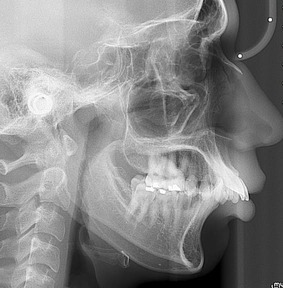Blog
مقالات
Teeth protrusion
Anterior teeth protrusion or what we call it “Protrusion” are one of most common cases in orthodontic clinics, and actually it comes after teeth crowding. Protrusion means, presence of distance more than normal between the incisal edges of upper and the lower front teeth (as this distance is supposed to be no more than 2 - 1 mm).

Protrusion may occur due to:
1. Protruding of upper jaw forward, or retrusion of lower jaw too backward, or both
forms together.
2. Because of excessive protrusion of the upper front teeth -only the teeth not the jaw bone- or retrusion of lower front teeth backward, or both together.
3. Mixture of problems in jawbone, and front teeth together.
The prevalence of this problem among the population of the Middle East and Asia has reached 10-15%, while its prevalence in North America, Europe and North Africa is 20%.
People may asked what is the reasons which lead upper jaw or teeth to protrude forward or Lowe jaw or teeth to move backward.
In fact, there are several reasons for Protrusion such as:
1. Mouth breathing:
Normal breathing is through the nose, but in some cases, due to blockage or narrowing of the normal respiratory passages, breathing from the mouth becomes compulsory.
“We will talk in a separate article about this problem and its negative impact on the jaw and teeth growth”
2. Thumb Sucking habit:
Thumb sucking is considered as normal behavior until the age of 4 years, but the continuation of this habit after the eruption of upper front teeth, will adversely affect the teeth and the growth of the jaws, and one of the results of the continuation of this habit is a protrusion.
“also will be talked About this problem in detail in a separate article.”
3. Genetics:
Genetics plays an essential role in the transmission of the inherited traits from parents to children regarding the size of the jaws. If the traits of a large upper jaw in the father transmitted to his child as well as the traits of a small jaw size had transmitted to the child from his mother, the child will suffer from protrusion.

4. The habit of sucking orbiting the lower lip:
The lower lip and the tissues that cover the chin, are muscles and can move the teeth in case that the pressure lasts on teeth for a long time.
This habit may lead to pushing upper front teeth forward and lower front teeth backward which leads to the emergence of protrusion.

5. Losing a tooth or more from the front teeth in the lower jaw -at an early age - due to trauma or an accident, will have a negative effect on the growth of lower anterior region of lower jaw or inclination of lower front teeth backward.


6. Chronic infections or fractures in the jaw joint, which may lead to erosion of the joint or the occurrence of adhesions, which leads to impeding the movement of the lower jaw and moving it to the posterior position, resulting in protrusion.
Treating protrusion requires an orthodontic treatment, which can take many ways, and choosing a treatment method to depend on the following factors:
1-Patient’s age:
The method of treating a 10 years old child is completely different
from a 40 years old woman.
2-Origin of protrusion problem:
For example, oral breathing and finger sucking must be treated in parallel with orthodontic treatment to correct the protrusion, and the treatment of protrusion due to the lower jaw retrusion is completely different than the treatment of protrusion because of protruded upper jaw.
3-Severity of protrusion
In severe cases, we may need dental extraction or even orthodontic surgery on one or both jaws, while in minor cases we may need only minor intervention.
4-If protrusion is accompanied with other orthodontic problems, such as crowded
teeth, open bite, or deep bite.
The main methods used to correct protrusion orthodontically are:
1.Functional appliance:
For more information, you can review my article about functional orthodontic appliance. We often use this technique with children (between 10 to 13 years) to direct the growth of their lower jaw in forward direction.
2. Extraction the upper teeth:
usually, we extract two premolars, one from each side of the upper jaw to provide a sufficient space to retract upper front teeth backward and reduce protrusion. The entire extracted tooth space is closed completely orthodontically, and ther will be no spaces at the end of treatment.




3. Orthodontic surgery:
In severe cases which are resulting from a defect in one or both jaws, and when the protrusion has a negative effect on the esthetic of facial profile, we resort to the orthognathic surgery .
We perform surgery after the age of eighteen – after stoppage of growth - and we need to put orthodontic braces to prepare both jaws for surgery later. For more information you can review my article about orthognathic surgery.

At the end of this article, I want to highlight the importance of starting our children first dental checkup at an early age, and to start first orthodontic checkup at age of seven. Early detection of Protrusion problem or one of its causes, can contribute in reducing the severity of the problem and minimize treatment time with the lowest harms and costs.